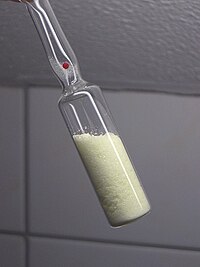
Photo from wikipedia
Elemental white phosphorus (P4) is a key feedstock for the entire phosphorus-derived chemicals industry, spanning everything from herbicides to food additives. The electrochemical reduction of phosphate salts could enable the… Click to show full abstract
Elemental white phosphorus (P4) is a key feedstock for the entire phosphorus-derived chemicals industry, spanning everything from herbicides to food additives. The electrochemical reduction of phosphate salts could enable the sustainable production of P4; however, such electrosynthesis requires the cleavage of strong, inert P–O bonds. By analogy to the promotion of bond activation in aqueous electrolytes with high proton activity (Brønsted–Lowry acidity), we show that low oxide anion activity (Lux–Flood acidity) enhances P–O bond activation in molten salt electrolytes. We develop electroanalytical tools to quantify the oxide dependence of phosphate reduction, and find that Lux acidic phosphoryl anhydride linkages enable selective, high-efficiency electrosynthesis of P4 at a yield of 95% Faradaic efficiency. These fundamental studies provide a foundation that may enable the development of low-carbon alternatives to legacy carbothermal synthesis of P4.
Journal Title: ACS Central Science
Year Published: 2023
Link to full text (if available)
Share on Social Media: Sign Up to like & get
recommendations!